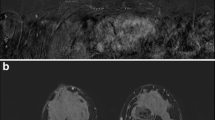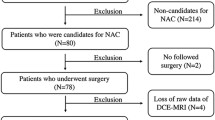Abstract
Objectives
To retrospectively investigate whether the lesion-to-background parenchymal signal enhancement ratio (SER) on breast MRI can distinguish pathological complete response (pCR) from minimal residual cancer following neoadjuvant chemotherapy (NAT), and compare its performance with the conventional criterion.
Methods
216 breast cancer patients who had undergone NAT and MRI and achieved pCR or minimal residual cancer on surgical histopathology were included. Clinical-pathological features, SER and lesion size on MR images were analysed. Multivariate logistic regression, ROC curve and McNemar’s test were performed.
Results
SER on early-phase MR images was independently associated with pCR (odds ratio [OR], 0.286 [95% CI: 0.113–0.725], p = .008 for Reader 1; OR, 0.306 [95% CI: 0.111–0.841], p = .022 for Reader 2). Compared with the conventional criterion, SER ≤1.6 increased AUC (0.585–0.599 vs. 0.709–0.771, p=.001-.033) and specificity (21.9–27.4% vs. 80.8–86.3%, p <.001) in identifying pCR. SER ≤1.6 and/or size ≤0.2 cm criterion showed the highest specificity of 90.4%.
Conclusion
SER on early-phase MR images was independently associated with pCR, and showed improved AUC and specificity compared to the conventional criterion. The combined criterion of SER and size could be used to select candidates to avoid surgery in a future study.
Key points
• Compared with conventional criterion, SER ≤ 1.6 criterion increased AUC and specificity.
• Simple measurement of signal intensity could differentiate pCR from minimal residual cancer.
• SER ≤1.6 and/or size≤0.2cm criterion showed the highest specificity of 90.4 %.
• The combined criterion could be used for a study to avoid surgery.


Similar content being viewed by others
Abbreviations
- DCIS:
-
Ductal carcinoma in situ
- HER2:
-
Human epidermal growth factor receptor type 2
- HR:
-
Hormone receptor
- ICC:
-
Intraclass correlation coefficient
- NAT:
-
Neoadjuvant chemotherapy
- pCR:
-
Pathological complete response
- SER:
-
Signal enhancement ratio
References
Rastogi P, Anderson SJ, Bear HD et al (2008) Preoperative chemotherapy: updates of national surgical adjuvant breast and bowel project protocols B-18 and B-27. J Clin Oncol 26:778–785
Mieog J, Van der Hage J, Van De Velde C (2007) Neoadjuvant chemotherapy for operable breast cancer. Br J Surg 94:1189–1200
King TA, Morrow M (2015) Surgical issues in patients with breast cancer receiving neoadjuvant chemotherapy. Nat Rev Clin Oncol 12:335–343
Kong X, Moran MS, Zhang N, Haffty B, Yang Q (2011) Meta-analysis confirms achieving pathological complete response after neoadjuvant chemotherapy predicts favourable prognosis for breast cancer patients. Eur J Cancer 47:2084–2090
Symmans WF, Peintinger F, Hatzis C et al (2007) Measurement of residual breast cancer burden to predict survival after neoadjuvant chemotherapy. J Clin Oncol 25:4414–4422
von Minckwitz G, Schneeweiss A, Loibl S et al (2014) Neoadjuvant carboplatin in patients with triple-negative and HER2-positive early breast cancer (GeparSixto; GBG 66): a randomised phase 2 trial. Lancet Oncol 15:747–756
Houssami N, Macaskill P, von Minckwitz G, Marinovich ML, Mamounas E (2012) Meta-analysis of the association of breast cancer subtype and pathologic complete response to neoadjuvant chemotherapy. Eur J Cancer 48:3342–3354
van la Parra RF, Kuerer HM (2016) Selective elimination of breast cancer surgery in exceptional responders: historical perspective and current trials. Breast Cancer Res 18:1
Heil J, Kümmel S, Schaefgen B et al (2015) Diagnosis of pathological complete response to neoadjuvant chemotherapy in breast cancer by minimal invasive biopsy techniques. Br J Cancer 113:1565–1570
Heil J, Schaefgen B, Sinn P et al (2016) Can a pathological complete response of breast cancer after neoadjuvant chemotherapy be diagnosed by minimal invasive biopsy? Eur J Cancer 69:142–150
Kuerer HM, Rauch GM, Krishnamurthy S et al (2017) A Clinical Feasibility Trial for Identification of Exceptional Responders in Whom Breast Cancer Surgery Can Be Eliminated Following Neoadjuvant Systemic Therapy. Ann Surg. https://doi.org/10.1097/SLA.0000000000002313
Lobbes M, Prevos R, Smidt M et al (2013) The role of magnetic resonance imaging in assessing residual disease and pathologic complete response in breast cancer patients receiving neoadjuvant chemotherapy: a systematic review. Insights Imaging 4:163–175
Marinovich ML, Houssami N, Macaskill P et al (2013) Meta-analysis of magnetic resonance imaging in detecting residual breast cancer after neoadjuvant therapy. J Natl Cancer Inst 105:321–333
Marinovich ML, Macaskill P, Irwig L et al (2015) Agreement between MRI and pathologic breast tumor size after neoadjuvant chemotherapy, and comparison with alternative tests: individual patient data meta-analysis. BMC Cancer 15:662
Yuan Y, Chen X-S, Liu S-Y, Shen K-W (2010) Accuracy of MRI in prediction of pathologic complete remission in breast cancer after preoperative therapy: a meta-analysis. Am J Roentgenol 195:260–268
De Los Santos JF, Cantor A, Amos KD et al (2013) Magnetic resonance imaging as a predictor of pathologic response in patients treated with neoadjuvant systemic treatment for operable breast cancer. Cancer 119:1776–1783
Schrading S, Kuhl CK (2015) Breast cancer: influence of taxanes on response assessment with dynamic contrast-enhanced MR imaging. Radiology 277:687–696
Böttcher J, Renz DM, Zahm D-M et al (2014) Response to neoadjuvant treatment of invasive ductal breast carcinomas including outcome evaluation: MRI analysis by an automatic CAD system in comparison to visual evaluation. Acta Oncol 53:759–768
Bouzón A, Acea B, Soler R et al (2016) Diagnostic accuracy of MRI to evaluate tumour response and residual tumour size after neoadjuvant chemotherapy in breast cancer patients. Radiol Oncol 50:73–79
Gu Y-L, Pan S-M, Ren J, Yang Z-X, Jiang G-Q (2017) The role of magnetic resonance imaging in detection of pathological complete remission in breast cancer patients treated with neoadjuvant chemotherapy: a meta-analysis. Clin Breast Cancer 17:245–255
Santamaría G, Bargalló X, Fernández PL, Farrús B, Caparrós X, Velasco M (2017) Neoadjuvant Systemic Therapy in Breast Cancer: Association of Contrast-enhanced MR Imaging Findings, Diffusion-weighted Imaging Findings, and Tumor Subtype with Tumor Response. Radiology 283:663–672
Breast cancer staging: the 7th edition of the AJCC Cancer Staging Manual.
Sinn H, Schmid H, Junkermann H et al (1994) Histologische Regression des Mammakarzinoms nach primärer (neoadjuvanter) Chemotherapie. Geburtshilfe Frauenheilkd 54:552–558
von Minckwitz G, Untch M, Blohmer J-U et al (2012) Definition and impact of pathologic complete response on prognosis after neoadjuvant chemotherapy in various intrinsic breast cancer subtypes. J Clin Oncol 30:1796–1804
Hammond MEH, Hayes DF, Dowsett M et al (2010) American Society of Clinical Oncology/College of American Pathologists guideline recommendations for immunohistochemical testing of estrogen and progesterone receptors in breast cancer (unabridged version). Arch Pathol Lab Med 134:e48–e72
Wolff AC, Hammond MEH, Hicks DG et al (2013) Recommendations for human epidermal growth factor receptor 2 testing in breast cancer: American Society of Clinical Oncology/College of American Pathologists clinical practice guideline update. Arch Pathol Lab Med 138:241–256
Youden WJ (1950) Index for rating diagnostic tests. Cancer 3:32–35
DeLong ER, DeLong DM, Clarke-Pearson DL (1988) Comparing the areas under two or more correlated receiver operating characteristic curves: a nonparametric approach. Biometrics 837–845
Landis JR, Koch GG (1977) The measurement of observer agreement for categorical data. biometrics 159–174
Park CC, Mitsumori M, Nixon A et al (2000) Outcome at 8 years after breast-conserving surgery and radiation therapy for invasive breast cancer: influence of margin status and systemic therapy on local recurrence. J Clin Oncol 18:1668–1675
Wasser K, Sinn H, Fink C et al (2003) Accuracy of tumor size measurement in breast cancer using MRI is influenced by histological regression induced by neoadjuvant chemotherapy. Eur Radiol 13:1213–1223
Loo CE, Straver ME, Rodenhuis S et al (2011) Magnetic resonance imaging response monitoring of breast cancer during neoadjuvant chemotherapy: relevance of breast cancer subtype. J Clin Oncol 29:660–666
McGuire KP, Toro-Burguete J, Dang H et al (2011) MRI staging after neoadjuvant chemotherapy for breast cancer: does tumor biology affect accuracy? Ann Surg Oncol 18:3149–3154
Hylton NM, Gatsonis CA, Rosen MA et al (2015) Neoadjuvant chemotherapy for breast cancer: functional tumor volume by MR imaging predicts recurrence-free survival—results from the ACRIN 6657/CALGB 150007 I-SPY 1 TRIAL. Radiology 279:44–55
Funding
This research has received funding from the Basic Science Research Program through the National Research Foundation of Korea funded by the Ministry of Education (NRF-2016R1D1A1B03933913).
Author information
Authors and Affiliations
Corresponding author
Ethics declarations
Guarantor
The scientific guarantor of this publication is Nariya Cho.
Conflict of interest
The authors of this manuscript declare no relationships with any companies whose products or services may be related to the subject matter of the article.
Statistics and biometry
No complex statistical methods were necessary for this paper.
Informed consent
Written informed consent was waived by the Institutional Review Board.
Ethical approval
Institutional Review Board approval was obtained.
Methodology
• retrospective
• diagnostic or prognostic study
• performed at one institution
Rights and permissions
About this article
Cite this article
Kim, SY., Cho, N., Shin, S.U. et al. Contrast-enhanced MRI after neoadjuvant chemotherapy of breast cancer: lesion-to-background parenchymal signal enhancement ratio for discriminating pathological complete response from minimal residual tumour. Eur Radiol 28, 2986–2995 (2018). https://doi.org/10.1007/s00330-017-5251-8
Received:
Revised:
Accepted:
Published:
Issue Date:
DOI: https://doi.org/10.1007/s00330-017-5251-8




